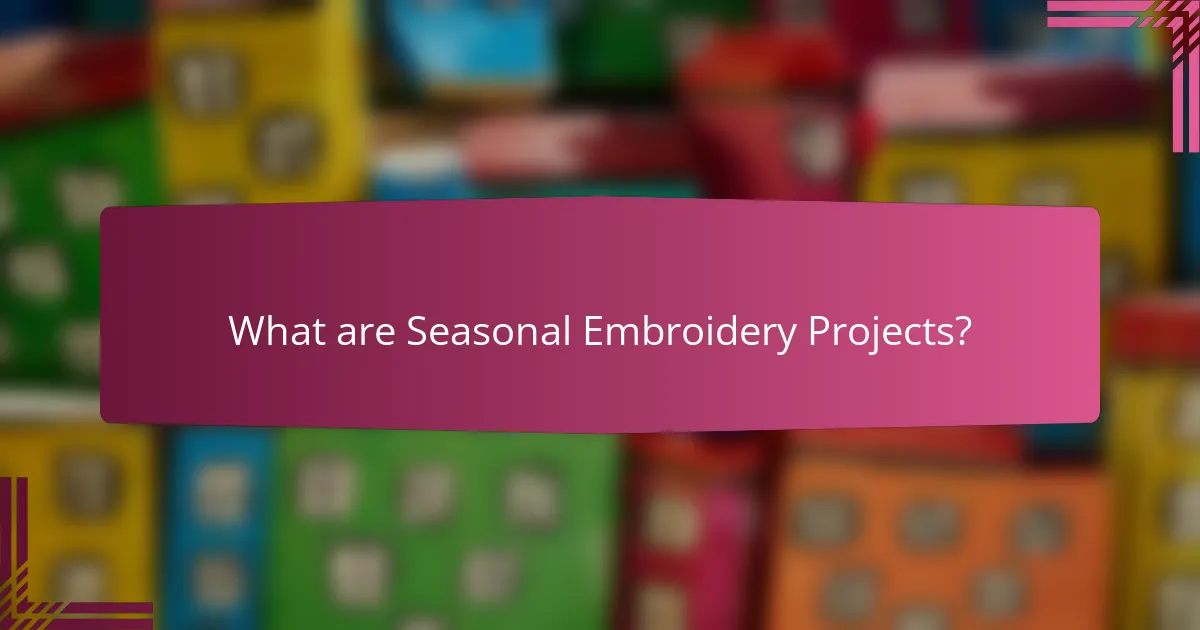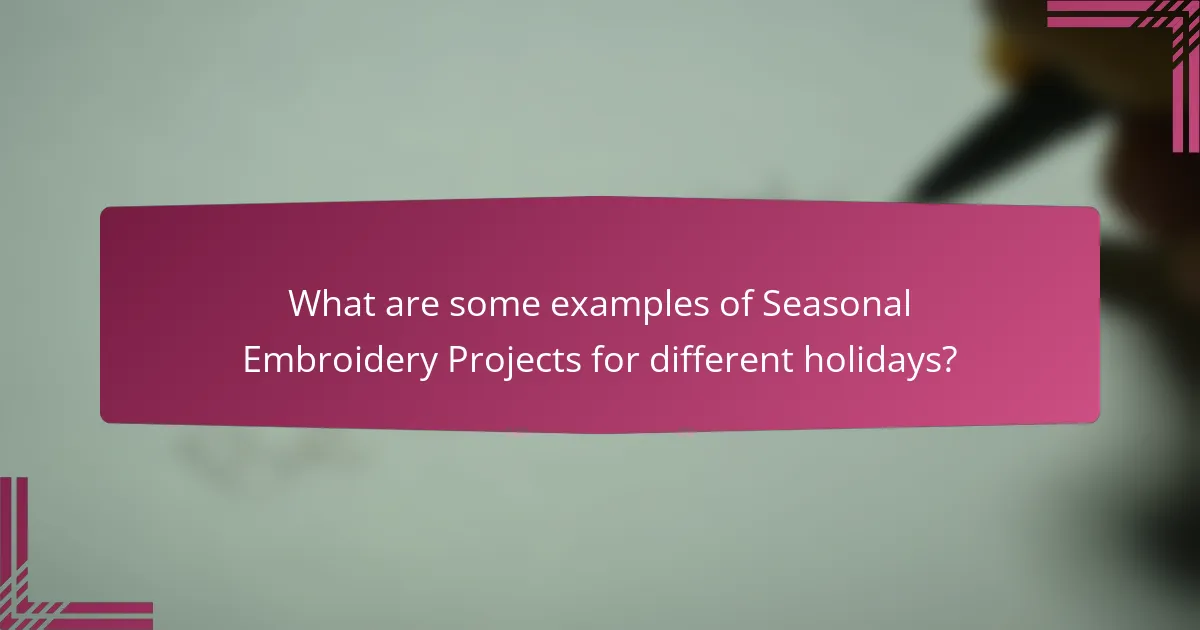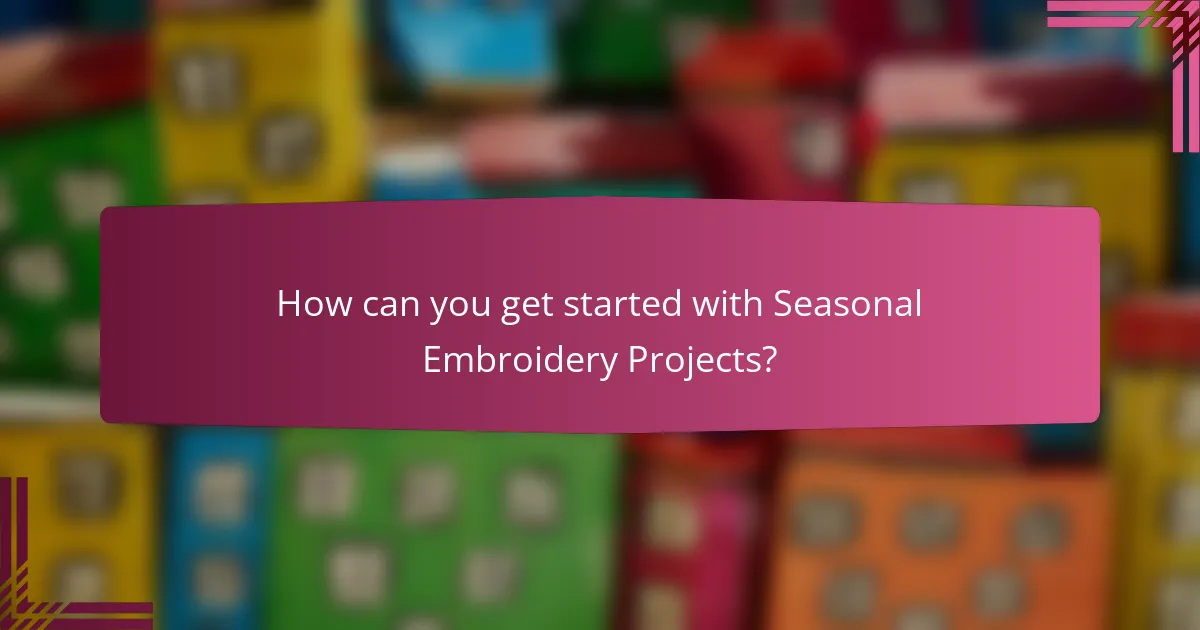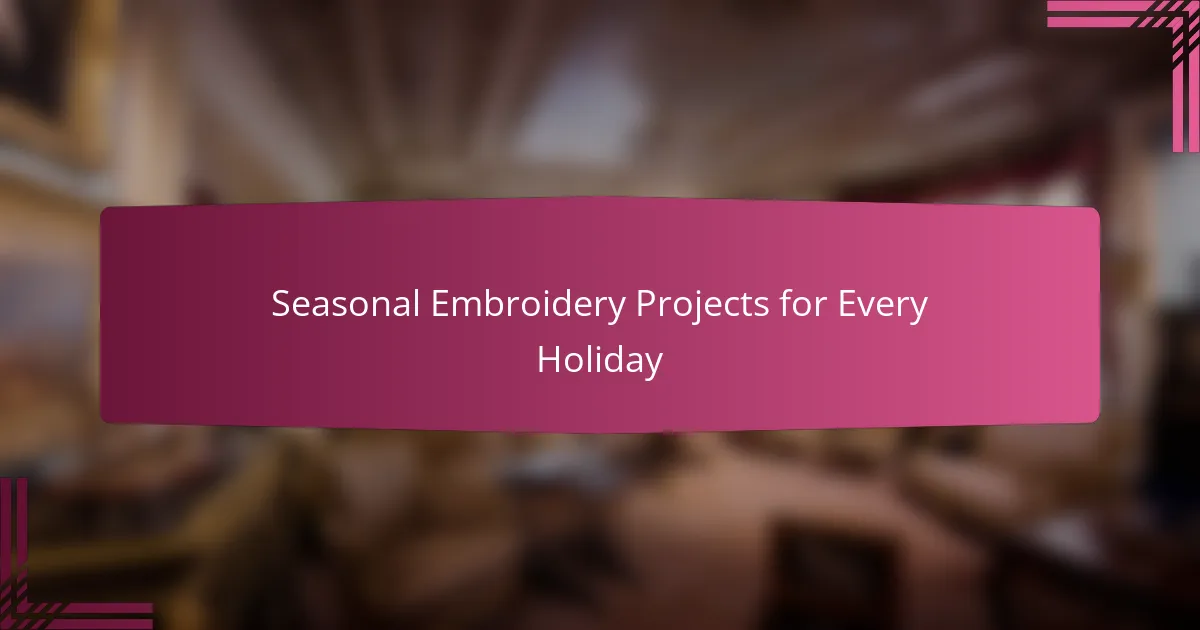
What are Seasonal Embroidery Projects?
Seasonal embroidery projects are needlework designs created to celebrate specific seasons or holidays. These projects often feature motifs like flowers for spring, leaves for autumn, or festive symbols for Christmas. They can be made on various items, including tablecloths, wall hangings, and clothing. Seasonal embroidery allows crafters to express creativity while enhancing their home decor. Popular examples include Easter eggs, Halloween pumpkins, and Thanksgiving turkeys. Many crafters participate in these projects to mark the changing seasons and create a festive atmosphere. Seasonal embroidery projects can also serve as thoughtful gifts or personal keepsakes.
How do Seasonal Embroidery Projects differ from regular embroidery?
Seasonal embroidery projects differ from regular embroidery in their thematic focus and timing. Seasonal projects are designed to reflect specific holidays or seasons, such as Christmas or Halloween. They often incorporate motifs, colors, and designs that are culturally significant to the respective holiday. Regular embroidery, on the other hand, may not adhere to any seasonal theme and can cover a wide range of subjects. Seasonal projects are typically created or showcased during particular times of the year, enhancing their relevance and appeal. This seasonal aspect often leads to unique patterns and techniques that are not commonly found in regular embroidery. Additionally, seasonal embroidery can serve as festive decor or gifts, making it distinct in purpose and execution.
What themes are commonly explored in Seasonal Embroidery Projects?
Common themes in seasonal embroidery projects include nature, holidays, and cultural symbols. Nature themes often depict seasonal changes, such as flowers in spring or leaves in autumn. Holiday themes celebrate specific occasions, featuring motifs like pumpkins for Halloween or snowflakes for winter. Cultural symbols reflect traditions and heritage, showcasing unique designs associated with various festivals. These themes resonate with the emotions and aesthetics of each season, making the projects relevant and engaging.
What materials are typically used for Seasonal Embroidery Projects?
Common materials for seasonal embroidery projects include embroidery floss, fabric, and needles. Embroidery floss is often made of cotton or polyester and comes in various colors. Fabric options typically include cotton, linen, or felt, providing a suitable base for embroidery. Needles used are usually embroidery or tapestry needles, designed for easy threading and fabric [censured]. Additionally, stabilizers may be used to support the fabric during stitching. Hoops or frames are also common to keep the fabric taut while working. These materials collectively enable the creation of intricate seasonal designs.
Why are Seasonal Embroidery Projects popular for holidays?
Seasonal embroidery projects are popular for holidays because they allow for personalized decorations. These projects often reflect the themes and colors associated with specific holidays. For instance, Christmas embroidery might feature snowflakes and ornaments. Many people enjoy creating handmade gifts for loved ones during festive seasons. The act of embroidery can also serve as a relaxing, creative outlet. Additionally, these projects can be a way to celebrate cultural traditions. Many families pass down embroidery patterns through generations. This practice fosters a sense of connection and nostalgia during holiday gatherings.
How do Seasonal Embroidery Projects enhance holiday celebrations?
Seasonal embroidery projects enhance holiday celebrations by adding personalized and decorative elements to festive occasions. These projects allow individuals to create unique designs that reflect the spirit of each holiday. For example, embroidery can be used to make themed table runners, ornaments, or wall hangings. Engaging in these projects fosters creativity and provides a sense of accomplishment. Additionally, handmade items often carry sentimental value, making them cherished keepsakes. According to a study by the Craft Yarn Council, 70% of crafters report that creating handmade items enhances their enjoyment of celebrations. Thus, seasonal embroidery projects contribute to a more meaningful and visually appealing holiday experience.
What benefits do Seasonal Embroidery Projects offer to crafters?
Seasonal embroidery projects offer crafters a variety of benefits. They enhance creativity by encouraging unique designs that reflect specific holidays or seasons. These projects also provide a sense of accomplishment upon completion, boosting confidence in crafting skills. Furthermore, seasonal embroidery can serve as a form of stress relief, allowing crafters to engage in a meditative process.
Additionally, these projects often lead to personalized gifts, making them meaningful for recipients. The act of creating seasonal pieces can foster community connections through shared crafting experiences. Seasonal themes can also inspire crafters to learn new techniques, expanding their skill set. Lastly, these projects can help decorate homes in a festive manner, adding a personal touch to seasonal celebrations.

What are some examples of Seasonal Embroidery Projects for different holidays?
Examples of seasonal embroidery projects for different holidays include Christmas ornaments, Easter egg designs, Halloween decorations, and Thanksgiving table runners. Christmas projects often feature festive motifs like snowflakes and Santa Claus. Easter embroidery may include bunnies and colorful eggs. Halloween projects can showcase pumpkins and ghosts. Thanksgiving designs typically highlight turkeys and autumn leaves. Each project reflects the holiday’s themes and traditions, making them popular choices for crafters.
What unique projects can be created for Christmas?
Unique projects for Christmas include personalized embroidered ornaments. These can be customized with names or dates. Another project is creating festive table runners with seasonal designs. Embroidered stockings are also popular, allowing for family names to be added. Additionally, custom embroidered gift bags can enhance gift presentation. Creating holiday-themed wall hangings can add charm to home decor. Each project allows for creativity and personalization, making them special for the holiday season.
How can you incorporate traditional motifs in Christmas embroidery?
Incorporating traditional motifs in Christmas embroidery can be achieved by selecting designs that reflect cultural heritage. Common motifs include snowflakes, Christmas trees, and nativity scenes. Use colors like red, green, gold, and white to evoke the festive spirit.
Stitching techniques such as cross-stitch or satin stitch enhance the traditional look. Fabrics like linen or cotton provide a classic base for these designs. Historical patterns can be researched from traditional embroidery books or online resources.
Many cultures have specific motifs that symbolize Christmas, such as Scandinavian patterns featuring stylized animals. Integrating these elements creates a unique blend of tradition and personal expression.
What are some innovative ideas for Christmas-themed embroidery?
Innovative ideas for Christmas-themed embroidery include creating personalized ornaments. These can feature names or dates for a unique touch. Another idea is to design festive table runners with holly or snowflake patterns. Embroidering holiday quotes on pillow covers adds a cozy feel. Advent calendars with embroidered pockets for treats are also popular. Creating custom Christmas stockings with family member names makes for a cherished keepsake. Lastly, embellishing gift bags with embroidered designs enhances gift presentation. Each of these ideas adds a personal and festive flair to holiday decor.
What are popular embroidery projects for Halloween?
Popular embroidery projects for Halloween include themed decorations and accessories. Common projects are embroidered pumpkins, ghosts, and bats. Many crafters create Halloween-themed table runners and wall hangings. Costumes can also feature embroidered elements like spider webs or witches. Embroidered trick-or-treat bags are popular among kids. Some people make Halloween-themed ornaments for their trees. Personalized Halloween shirts with spooky designs are also in demand. These projects reflect the festive spirit and creativity associated with the holiday.
What designs are most sought after for Halloween embroidery?
Popular designs for Halloween embroidery include pumpkins, ghosts, and bats. These motifs capture the festive spirit of the season. Additionally, designs featuring witches, spiders, and skulls are also highly sought after. According to industry trends, pumpkin patterns are particularly favored for their classic Halloween appeal. Ghost designs often add a playful touch to projects. Bats are popular for their association with spooky themes. Witches symbolize the magical aspect of Halloween. Overall, these designs reflect the holiday’s themes of fun and fright.
How can you use color to enhance Halloween embroidery projects?
Using color can significantly enhance Halloween embroidery projects. Bold colors like orange, black, and purple are traditional for Halloween. These colors evoke the holiday’s spooky and festive spirit. Incorporating metallic threads can add shimmer and depth. Using contrasting colors makes designs pop and catch the eye. Layering different shades can create a more dynamic effect. Seasonal color palettes can guide your choices for cohesive designs. Bright colors can attract attention to specific elements, like pumpkins or ghosts. Experimenting with color gradients can add a modern twist to classic designs.

How can you get started with Seasonal Embroidery Projects?
To get started with seasonal embroidery projects, begin by selecting a theme that aligns with the holiday or season. Choose designs that reflect seasonal motifs, such as flowers for spring or snowflakes for winter. Gather necessary materials, including fabric, embroidery threads, and tools like needles and hoops. Sketch or print your chosen design on the fabric to guide your embroidery. Start with basic stitches if you are a beginner, such as backstitch or satin stitch. Practice on scrap fabric to build confidence before working on your final piece. Consider joining online embroidery communities for tips and inspiration. Seasonal embroidery projects can enhance your home decor and make thoughtful gifts.
What tools and materials do you need to begin?
To begin seasonal embroidery projects, you need specific tools and materials. Essential tools include embroidery needles, embroidery hoops, and scissors. You will also require fabric suitable for embroidery, such as cotton or linen. Additionally, embroidery floss or thread in various colors is necessary for stitching. A marking pencil or fabric chalk is useful for transferring designs onto the fabric. Finally, a pattern or design guide will help you create your project. These items are fundamental for starting any embroidery project effectively.
How do you choose the right fabric for your embroidery projects?
To choose the right fabric for your embroidery projects, consider the type of embroidery technique you will use. Different techniques require different fabric types for optimal results. For example, lightweight fabrics like cotton are ideal for hand embroidery, while heavier fabrics like canvas work well for machine embroidery.
Also, consider the fabric’s weave. Tightly woven fabrics provide a stable base for intricate designs. Fabric weight is another factor; lighter fabrics are suitable for delicate designs, while heavier fabrics support bold patterns.
The fabric’s fiber content affects how it holds stitches. Natural fibers like cotton and linen are preferred for their breathability and ease of stitching. Additionally, consider the fabric’s color and texture, as these can enhance or detract from the embroidery design.
Finally, pre-wash the fabric to avoid shrinkage after the embroidery is complete. This ensures the finished project maintains its shape and quality.
What essential embroidery techniques should beginners learn?
Beginners should learn basic embroidery techniques such as the backstitch, satin stitch, and French knot. The backstitch creates strong lines and is useful for outlines. The satin stitch fills shapes with color and texture. French knots add decorative dots and texture to designs. Mastering these techniques provides a solid foundation for more complex projects. Each technique is commonly used in various embroidery patterns. Practicing these skills enhances overall embroidery proficiency.
What tips can help improve your Seasonal Embroidery Projects?
To improve your seasonal embroidery projects, focus on planning and selecting the right materials. Choose high-quality threads and fabrics that match the seasonal theme. Utilize proper embroidery techniques for each design, such as backstitch or satin stitch, to enhance detail. Incorporate seasonal colors to evoke the holiday spirit. Use templates or patterns to ensure consistency in design. Regularly practice your skills to gain confidence and precision. Lastly, experiment with different embroidery styles to add uniqueness to your projects. These practices can lead to more polished and visually appealing seasonal embroidery outcomes.
How can you effectively plan your embroidery designs?
To effectively plan your embroidery designs, start by selecting a theme relevant to the season or holiday. Consider the colors and motifs that align with that theme. Create a rough sketch to visualize the layout and elements. Choose appropriate fabrics that complement the design. Plan the stitching techniques that will enhance the overall look. Organize your materials, including threads, needles, and any embellishments. Set a timeline for each step of the project to ensure timely completion. Use embroidery software or tools for precision in design and planning. These steps help streamline the process and improve the final outcome.
What common mistakes should you avoid in Seasonal Embroidery Projects?
Common mistakes to avoid in seasonal embroidery projects include choosing the wrong fabric. Using fabric not suited for embroidery can lead to distortion. Another mistake is neglecting to pre-wash fabrics, which may cause shrinkage post-embroidery. Additionally, failing to use appropriate thread can result in fraying or color bleeding. Not planning the design layout properly can lead to uneven placement. Overlooking the importance of hooping correctly can cause puckering. Lastly, ignoring care instructions for finished pieces can diminish their quality over time.
Seasonal embroidery projects are needlework designs created to celebrate specific seasons or holidays, featuring motifs such as flowers, leaves, and festive symbols. This article explores the differences between seasonal and regular embroidery, common themes and materials used, and the benefits of engaging in these projects. It highlights popular examples for various holidays, innovative ideas for Christmas and Halloween, and essential techniques for beginners. The content provides practical tips for planning, executing, and improving seasonal embroidery projects, ensuring a meaningful and creative crafting experience.
